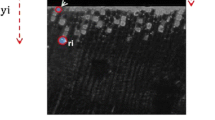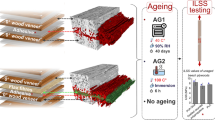Abstract
In the present study, fast-grown western hemlock (Tsuga heterophylla) was subjected to a thermal-hydro-mechanical (THM) treatment. Bond-line shear strength and durability were evaluated, and three parameters (substrate density, adhesive type and amount of adhesive spread) were investigated. To understand how THM processing affects bond performance, surface roughness and cell morphology of wood, before and after THM treatment, were observed. Adhesive penetration depths and patterns in untreated wood and THM-treated wood were also examined. In addition, Fourier transform infrared (FTIR) spectroscopy analysis of bond-line and microscopic observation of interphase region were conducted. Results revealed that polymeric diphenylmethane diisocyanate (PMDI) and polyurethane (PUR) had better bonding performance than phenol formaldehyde resin (PF). THM treatment improved bond durability, and THM plywood met the adhesive bond requirements of exterior plywood. THM treatment reduced surface roughness and porosity of wood. Adhesive penetration patterns were different in untreated wood and THM-treated wood and were affected by amount and type of adhesive. Pathways for adhesive flow into western hemlock were primarily tracheid lumens, ray cell lumens and the interconnecting pits. PF is the only adhesive that showed no evidence of flow via ray tissues or cell wall penetration. Since bond-line shear strength largely depends upon the weakest link across the laminas, ultimate strength or percent wood failure does not always depend merely on adhesive penetration. In addition, FTIR analysis showed different chemical reactions and bonding mechanisms, which provides a possible explanation of THM-caused changes in bonding performance at the molecular level.








Similar content being viewed by others
References
Brady DE, Kamke FA (1988) Effects of hot-pressing parameters on resin penetration. For Prod J 38(11–12):63–68
Cao Y (2010) Characterization of PF/PVAC hybrid adhesive-wood interaction and its effect on wood strand composites performance. Washington State University, Pullman, Washington
Chandler JG, Brandon RL, Frihart CR (2005) Examination of adhesive penetration in modified wood using fluorescence microscopy. Paper presented at the ASC Spring 2005 Convention and Exposition, Columbus, OH, April 17–20
D5266-99 (1999) Standard practice for estimating the percentage of wood failure in adhesive bonded joints. ASTM International, West Conshohocken
D905-98 (1998) Standard test method for strength properties of adhesive bonds in shear by compression loading. ASTM International, West Conshohocken
Dougal EF, Krahmer RL, Wellons JD, Kanarek P (1980) Glueline characteristics and bond durability of southeast asian species after solvent-extraction and planing of veneers. For Prod J 30(7):48–53
Fang CH, Mariotti N, Cloutier A, Koubaa A (2012) Densification of wood veneers by compression combined with heat and steam. Eur J Wood Prod 70(1–3):155–163
Gollob L, Krahmer RL, Wellons JD, Christiansen AW (1985) Relationship between chemical characteristics of phenol-formaldehyde resins and adhesive performance. For Prod J 35(3):42–48
Gruver TM, Brown NR (2006) Penetration and performance of isocyanate wood binders on selected wood species. BioResources 1(2):233–247
Johnson SE, Kamke FA (1992) Quantitative-analysis of gross adhesive penetration in wood using fluorescence microscopy. J Adhes 40(1):47–61
Johnson SE, Kamke FA (1994) Characteristics of phenol-formaldehyde adhesive bonds in steam injection pressed flakeboard. Wood Fiber Sci 26(2):259–269
Kamke FA, Lee JN (2007) Adhesive penetration in wood—a review. Wood Fiber Sci 39(2):205–220
Kamke FA, Sizemore H (2008) Viscoelastic thermal compression of wood. US7404422 B2
Kutnar A, Kamke FA (2012) Compression of wood under saturated steam, superheated steam, and transient conditions at 150 °C, 160 °C, and 170 °C. Wood Sci Technol 46(1–3):73–88
Kutnar A, Kamke FA (2013) Transverse compression behavior of Douglas-fir (Pseudotsuga menziesii) in saturated steam environment. Eur J Wood Prod 71(4):443–449
Kutnar A, Šernek M (2007) Densification of wood. Zbornik gozdarstva in lesarstva 82:53–62
Liu HL, Kamke FA, Guo KQ (2013) Integrated drying and thermo-hydro-mechanical modification of western hemlock veneer. Eur J Wood Prod 71(2):173–181
Liu HL, Shang J, Chen XQ, Kamke FA, Guo KQ (2014a) The influence of thermal-hydro-mechanical processing on chemical characterization of Tsuga heterophylla. Wood Sci Technol 48(2):373–392
Liu HL, Guo KQ, Kamke FA, Cuong TV (2014b) A novel modification technology of fast-growing wood veneer: softening at high temperature with saturated steam and transverse compression in a sealed environment. Scientia Silvae Sinicae 50(1):149–155
Marcinko JJ, Devathala S, Rinaldi PL, Bao SC (1998) Investigating the molecular and bulk dynamics of PMDI/wood and UF/wood composites. For Prod J 48(6):81–84
Marra AA (1992) Technology of wood bonding: principles in practice. VNR structural engineering, 1st edn. Van Nostrand Reinhold, New York
Modzel G, Kamke FA, De Carlo F (2011) Comparative analysis of a wood-adhesive bondline. Wood Sci Technol 45:147–158
Navi P, Girardet F (2000) Effects of thermos-hydro-mechanical treatment on the structure and properties of wood. Holzforschung 54(3):287–293
Navi P, Sandberg D (2012) Thermo-hydro-mechanical wood processing. EPFL Press, Lausanne
Sandberg D, Haller P, Navi P (2013) Thermo-hydro and thermo-hydro-mechanical wood processing: an opportunity for future environmentally friendly wood products. Wood Mat Sci Eng 8(1):64–88
Sernek M, ResniK J, Kmake FA (2007) Penetration of liquild urea-formadehyde adhesive into beech wood. Wood Fiber Sci 31(1):41–48
Siau JF (1995) Wood: influence of moisture on physical properties. Department of Wood Science and Forest Products, Virginia Polytechnic Institute and State University
Standfest G, Kutnar A, Plank B, Petutschnigg A, Kamke FA, Dunky M (2013) Microstructure of viscoelastic thermal compressed (THM) wood using computed microtomography. Wood Sci Technol 47(1):121–139
U.S. Department of Commerce (2009) Voluntary Product Standard PS 1-09 Structural Plywood. National Institute of Standards and Technology
Vick CB (1999) Adhesive bonding of wood materials. In: Agriculture FSUDo (ed) Wood handbook: wood as an engineering material. Forest Products Research, Madison, pp 91–924
Acknowledgements
Technical assistance from Chuan Li, Chusheng Qi, Jesse Paris, Will Holloman and Xianqing Chen is appreciated.
Funding
This work was supported by the Chinese Ministry of Agriculture [Grant Number 201003063-07] and Oregon BEST, Oregon State University (Corvallis, OR, USA).
Author information
Authors and Affiliations
Corresponding author
Rights and permissions
About this article
Cite this article
Liu, H., Shang, J., Kamke, F.A. et al. Bonding performance and mechanism of thermal-hydro-mechanical modified veneer. Wood Sci Technol 52, 343–363 (2018). https://doi.org/10.1007/s00226-017-0982-x
Received:
Published:
Issue Date:
DOI: https://doi.org/10.1007/s00226-017-0982-x




